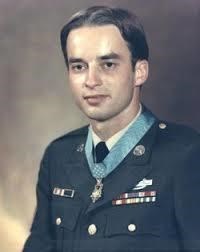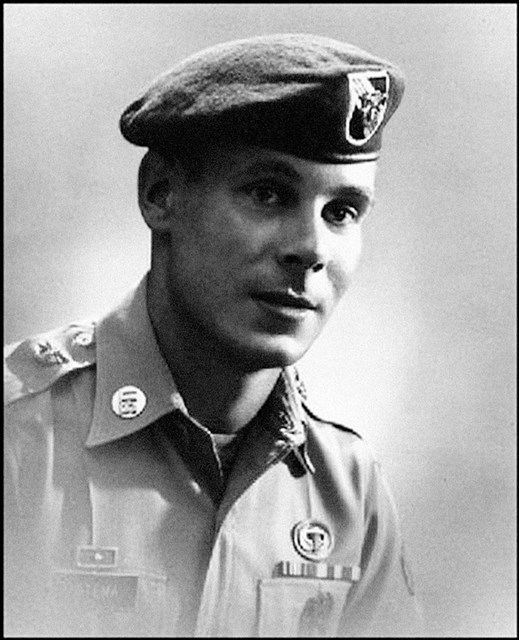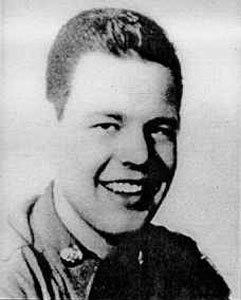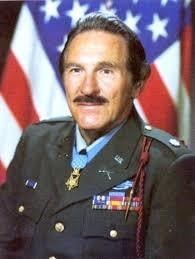Heroes Adventure Lab Bonus
To find the cache you must complete the Heroes Adventure Lab. During the Heroes Adventure Lab you visited a number of our nations real heroes. The Adventure Lab does not offer sufficient space to share their Medal of Honor citations so they have been included here.

Staff Sergeant Lambers' official Medal of Honor citation reads:
"For conspicuous gallantry and intrepidity in action at the risk of his life above and beyond the call of duty. S/Sgt. (then Sgt.) Lambers distinguished himself in action while serving with the 3d platoon, Company A. The unit had established a night defensive position astride a suspected enemy infiltration route, when it was attacked by an estimated Viet Cong battalion.
During the initial enemy onslaught, the platoon leader fell seriously wounded and S/Sgt. Lambers assumed command of the platoon. Disregarding the intense enemy fire, S/Sgt. Lambers left his covered position, secured the platoon radio and moved to the command post to direct the defense.
When his radio became inoperative due to enemy action, S/Sgt. Lambers crossed the fire swept position to secure the 90mm recoilless rifle crew's radio in order to re-establish communications. Upon discovering that the 90mm recoilless rifle was not functioning, S/Sgt. Lambers assisted in the repair of the weapon and directed canister fire at point-blank range against the attacking enemy who had breached the defensive wire of the position.
When the weapon was knocked out by enemy fire, he single-handedly repulsed a penetration of the position by detonating claymore mines and throwing grenades into the midst of the attackers, killing 4 more of the Viet Cong with well aimed hand grenades. S/Sgt. Lambers maintained command of the platoon elements by moving from position to position under the hail of enemy fire, providing assistance where the assault was the heaviest and by his outstanding example inspiring his men to the utmost efforts of courage.
He displayed great skill and valor throughout the 5-hour battle by personally directing artillery and helicopter fire, placing them at times within 5 meters of the defensive position. He repeatedly exposed himself to hostile fire at great risk to his own life in order to redistribute ammunition and to care for seriously wounded comrades and to move them to sheltered positions.
S/Sgt. Lambers' superb leadership, professional skill and magnificent courage saved the lives of his comrades, resulted in the virtual annihilation of a vastly superior enemy force and were largely instrumental in thwarting an enemy offensive against Tây Ninh City. His gallantry at the risk of his life is in keeping with the highest traditions of the military service and reflects great credit upon himself, his unit, and the U.S. Army.

Sergeant Yntema's official Medal of Honor citation reads:
For conspicuous gallantry and intrepidity in action at the risk of his life and above and beyond the call of duty. Sgt. Yntema, U.S. Army, distinguished himself while assigned to Detachment A-431, Company D. As part of a larger force of civilian irregulars from Camp Cai Cai, he accompanied 2 platoons to a blocking position east of the village of Thong Binh, where they became heavily engaged in a small-arms fire fight with the Viet Cong. Assuming control of the force when the Vietnamese commander was seriously wounded, he advanced his troops to within 50 meters of the enemy bunkers. After a fierce 30 minute fire fight, the enemy forced Sgt. Yntema to withdraw his men to a trench in order to afford them protection and still perform their assigned blocking mission. Under cover of machinegun fire, approximately 1 company of Viet Cong maneuvered into a position which pinned down the friendly platoons from 3 sides. A dwindling ammunition supply, coupled with a Viet Cong mortar barrage which inflicted heavy losses on the exposed friendly troops, caused many of the irregulars to withdraw. Seriously wounded and ordered to withdraw himself, Sgt. Yntema refused to leave his fallen comrades. Under withering small arms and machinegun fire, he carried the wounded Vietnamese commander and a mortally wounded American Special Forces advisor to a small gully 50 meters away in order to shield them from the enemy fire. Sgt. Yntema then continued to repulse the attacking Viet Cong attempting to overrun his position until, out of ammunition and surrounded, he was offered the opportunity to surrender. Refusing, Sgt. Yntema stood his ground, using his rifle as a club to fight the approximately 15 Viet Cong attempting his capture. His resistance was so fierce that the Viet Cong were forced to shoot in order to overcome him. Sgt. Yntema's personal bravery in the face of insurmountable odds and supreme self-sacrifice were in keeping with the highest traditions of the military service and reflect the utmost credit upon himself, the 1st Special Forces, and the U.S. Army.

Cpl. Essebagger's official Medal of Honor citation reads:
Cpl. Essebagger, a member of Company A, distinguished himself by conspicuous gallantry and outstanding courage above and beyond the call of duty in action against the enemy. Committed to effect a delaying action to cover the 3d Battalion's withdrawal through Company A, Cpl. Essebagger, a member of 1 of 2 squads maintaining defensive positions in key terrain and defending the company's right flank, had participated in repulsing numerous attacks. In a frenzied banzai charge the numerically superior enemy seriously threatened the security of the planned route of withdrawal and isolation of the small force. Badly shaken, the grossly outnumbered detachment started to fall back and Cpl. Essebagger, realizing the impending danger, voluntarily remained to provide security for the withdrawal. Gallantly maintaining a l-man stand, Cpl. Essebagger raked the menacing hordes with crippling fire and, with the foe closing on the position, left the comparative safety of his shelter and advanced in the face of overwhelming odds, firing his weapon and hurling grenades to disconcert the enemy and afford time for displacement of friendly elements to more tenable positions. Scorning the withering fire and bursting shells, Cpl. Essebagger continued to move forward, inflicting destruction upon the fanatical foe until he was mortally wounded. Cpl. Essebagger's intrepid action and supreme sacrifice exacted a heavy toll in enemy dead and wounded, stemmed the onslaught, and enabled the retiring squads to reach safety. His valorous conduct and devotion to duty reflected lasting glory upon himself and was in keeping with the noblest traditions of the infantry and the U.S. Army.

LTC Urban's official Medal of Honor citation reads:
For conspicuous gallantry and intrepidity at risk of life above and beyond the call of duty: Lieutenant Colonel (then Captain) Matt Urban, 112-22-2414, United States Army, distinguished himself by a series of bold, heroic actions, exemplified by singularly outstanding combat leadership, personal bravery, and tenacious devotion to duty, during the period 14 June to 3 September 1944 while assigned to the 2nd Battalion, 60th Infantry Regiment, 9th Infantry Division. On 14 June, Captain Urban's company, attacking at Renouf, France, encountered heavy enemy small arms and tank fire. The enemy tanks were unmercifully raking his unit's positions and inflicting heavy casualties. Captain Urban, realizing that his company was in imminent danger of being decimated, armed himself with a bazooka. He worked his way with an ammo carrier through hedgerows, under a continuing barrage of fire, to a point near the tanks. He brazenly exposed himself to the enemy fire and, firing the bazooka, destroyed both tanks. Responding to Captain Urban's action, his company moved forward and routed the enemy. Later that same day, still in the attack near Orglandes, Captain Urban was wounded in the leg by direct fire from a 37mm tank-gun. He refused evacuation and continued to lead his company until they moved into defensive positions for the night. At 0500 hours the next day, Captain Urban, though badly wounded, directed his company in another attack. One hour later he was again wounded. Suffering from two wounds, one serious, he was evacuated to England.
In mid-July, while recovering from his wounds, he learned of his unit's severe losses in the hedgerows of Normandy. Realizing his unit's need for battle-tested leaders, he voluntarily left the hospital and hitchhiked his way back to his unit near St. Lo, France. Arriving at the 2d Battalion Command Post at 1130 hours, 25 July, he found that his unit had jumped-off at 1100 hours in the first attack of "Operation Cobra". Still limping from his leg wound, Captain Urban made his way forward to retake command of his company. He found his company held up by strong enemy opposition. Two supporting tanks had been destroyed and another, intact but with no tank commander or gunner, was not moving. He located a lieutenant in charge of the support tanks and directed a plan of attack to eliminate the enemy strong-point. The lieutenant and a sergeant were immediately killed by the heavy enemy fire when they tried to mount the tank. Captain Urban, though physically hampered by his leg wound and knowing quick action had to be taken, dashed through the scathing fire and mounted the tank. With enemy bullets ricocheting from the tank, Captain Urban ordered the tank forward and, completely exposed to the enemy fire, manned the machine gun and placed devastating fire on the enemy. His action, in the face of enemy fire, galvanized the battalion into action and they attacked and destroyed the enemy position. On 2 August, Captain Urban was wounded in the chest by shell fragments and, disregarding the recommendation of the Battalion Surgeon, again refused evacuation. On 6 August, Captain Urban became the commander of the 2d Battalion. On 15 August, he was again wounded but remained with his unit.
On 3 September, the 2d Battalion was given the mission of establishing a crossing-point on the Meuse River near Heer, Belgium. The enemy planned to stop the advance of the allied Army by concentrating heavy forces at the Meuse. The 2d Battalion, attacking toward the crossing-point, encountered fierce enemy artillery, small arms and mortar fire which stopped the attack. Captain Urban quickly moved from his command post to the lead position of the battalion. Reorganizing the attacking elements, he personally led a charge toward the enemy's strong-point. As the charge moved across the open terrain, Captain Urban was seriously wounded in the neck. Although unable to talk above a whisper from the paralyzing neck wound, and in danger of losing his life, he refused to be evacuated until the enemy was routed and his battalion had secured the crossing-point on the Meuse River. Captain Urban's personal leadership, limitless bravery, and repeated extraordinary exposure to enemy fire served as an inspiration to his entire battalion. His valorous and intrepid actions reflect the utmost credit on him and uphold the noble traditions of the United States Army.